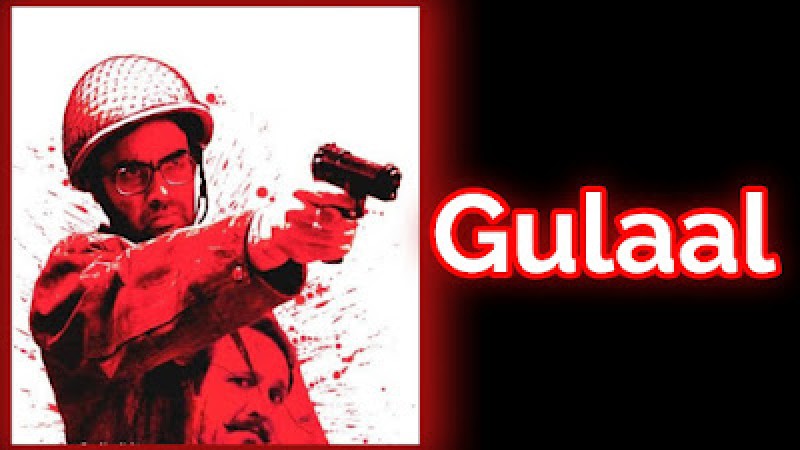
The power of cinema as a vehicle for artistic expression and social commentary has never diminished. The need for censorship, however, to make sure that films don't incite violence, support hate speech, or offend sensibilities frequently clashes with this freedom of expression. One such controversy occurred when the Indian censor board decided to remove two dialogues from the Anurag Kashyap-directed movie "Gulaal," one of which referenced Mahatma Gandhi and Dr. Babasaheb Ambedkar and the other of which discussed the creation of the national anthem of India. We will examine the motivations for this censorship, the discussion it sparked, and the broader ramifications for artistic freedom and historical accuracy in Indian cinema in this article.
Hindi movie "Gulaal," directed by Anurag Kashyap, was released in 2009. The movie, which explores themes of power, politics, and the quest for identity, is set against the backdrop of Rajasthan's student politics. Although it was not without controversy, it won praise from the critics for its daring storytelling and razor-sharp dialogue.
Prior to discussing the specific censorship of the dialogue in "Gulaal," it is crucial to comprehend the function and aim of censorship in Indian cinema. The task of approving films for public viewing in India falls under the purview of the Central Board of Film Certification (CBFC), also known as the censor board. The Cinematograph Act of 1952 includes provisions to prevent the incitement of violence, religious hatred, and obscenity. The board reviews films to ensure they comply with these rules. Censorship promotes social harmony and protects people from harm, but it also calls into question artistic freedom and historical accuracy.
Two specific dialogues that were removed from "Gulaal" by the CBFC are at the centre of the controversy surrounding the film. Mahatma Gandhi and Dr. Babasaheb Ambedkar, two legendary figures in Indian history, are mentioned in the opening dialogue. The second dialogue explores the history of the national anthem of India, "Jana Gana Mana." Let's take a closer look at each of these dialogues that were edited.
One of the characters in the movie says something contentious linking Mahatma Gandhi and Dr. Babasaheb Ambedkar in a way that could be taken as disrespectful. Some groups in society were outraged by this conversation because they thought it was important to respect these historical figures. As a result, the CBFC made the decision to censor this conversation in order to prevent any unrest or controversies.
"Gulaal" also features a conversation about the creation of India's National Anthem, "Jana Gana Mana." The protagonist raises concerns about the circumstances surrounding the anthem's selection as the country's anthem and alludes to a possible political motivation. This conversation caused controversy as well, which prompted the CBFC to censor it.
The censorship of these scenes in "Gulaal" sparked a contentious discussion in India. Filmmakers should be permitted to depict historical figures and events in a way that serves the narrative and artistic vision, even if it contradicts popular opinion, according to proponents of creative freedom. They argued that because film is a form of artistic expression, censorship shouldn't prevent the investigation of intricate themes and characters.
On the other hand, those who supported the censor board's choice argued that because some historical figures, such as Mahatma Gandhi and Dr. Babasaheb Ambedkar, are revered in Indian culture, any depiction that might be interpreted as disrespectful should be limited. They emphasised how crucial it is to keep social harmony and to respect the opinions of the general public.
The national anthem of India was also a topic of discussion. While some people thought the movie's depiction of its beginnings was historically incorrect and possibly deceptive, others thought it was appropriate for cinema to question accepted narratives and consider alternative viewpoints.
The censorship of the dialogue in "Gulaal" raises critical issues regarding the Indian film industry's attempt to strike a balance between artistic freedom and historical accuracy. It also emphasises the difficulties filmmakers face when navigating a complicated cultural and political environment.
The conflict between creative freedom and the requirement to be sensitive to historical and cultural symbols is one of the main issues at the centre of this debate. Filmmakers should be free to explore unusual stories and characters, but they also need to be aware of the possible repercussions of questioning deeply held beliefs.
The controversy surrounding "Gulaal" emphasises how crucial historical accuracy is in films. Filmmakers can use artistic licence to interpret historical figures and events in unique ways, but they should aim for accuracy and steer clear of embellishing the truth, especially when dealing with famous people and events.
The controversy forces a reexamination of censorship's function in Indian cinema. While censorship is essential for maintaining social harmony and preventing harm, it should be used sparingly, in accordance with well-defined rules, and in a transparent manner to avoid any potential biases.
The censorship of two dialogues from the movie "Gulaal" sparked an intense discussion about artistic freedom, historical accuracy, and the function of censorship in Indian film. Filmmakers, artists, and society as a whole must consider how to strike a balance between the desire to investigate unusual narratives and the need for sensitivity and respect for historical figures. Censorship is necessary to preserve social harmony, but in order to uphold the democratic ideals of free speech, it must be carried out in an open and equitable manner. The controversy surrounding "Gulaal" ultimately serves as a reminder of the difficulties and obligations that come with using cinema as a platform for social commentary and creative expression.
The Enigmatic Connection Between 'Life in a Metro' and 'The Apartment'
Vidya Balan's Parallel Lives as an RJ on Screen
The Electric Chemistry of Ranbir and Deepika in 'Yeh Jawaani Hai Deewani'